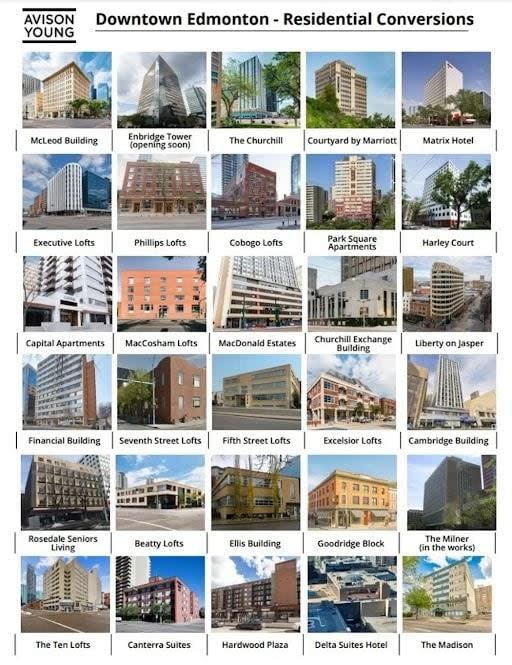Extreme makeovers: Interest grows in converting empty Edmonton office towers into housing

Edmonton is joining other cities filling empty or old office towers with apartments to revitalize the downtown core.
The process has been going on for decades, and at least 30 such buildings downtown have already been converted from office space to housing units.
Next month, city council's urban planning committee will see a report detailing options for a new incentive program that could help developers convert more underused office towers into residential buildings.
At 24.1 per cent in the second quarter of this year, Edmonton's downtown office vacancy rate was the third highest in Canada, according to real estate service and investment firm CBRE Limited. The national office vacancy rate for the same three-month period was 18.1 per cent.
"As the vacancy rate has ticked up and we've seen the other shoe drop, all of a sudden it's a bigger conversation," said Puneeta McBryan, executive director of the Downtown Business Association.
"How do we eliminate some of our excess office stock? How do we bring new life to these really outdated, irrelevant buildings and increase our residential population?"
In April, Ward Nakota Isga Coun. Andrew Knack suggested the city find ways to encourage developers to consider residential conversions.
Councillors supported Knack's motion to have administration recommend ways to boost the number of residential and/or hotel units downtown, using potential measures such as legislative changes or financial incentives.
He and others, including Ward O-day'min Coun. Anne Stevenson, are hoping for an influx of residents.
Like Knack, Stevenson also wants to see what an incentive program could look like for developers and the community. A report is expected to be presented to council's urban planning committee around the end of October.
"Downtown is a physical place, but the lifeblood is the people," Stevenson said. "When the pandemic hit, people left downtown. The heart of our city stopped beating."
'The chicken or the egg'
According to the DBA, as many as 30 former office buildings have already found new life as residential space.
Most of those conversions in the city are 15 or more years old including the McLeod and Cambridge buildings and the Liberty Building on Jasper and 105th Street.
Anuj Gupta, president of Anu Developments, is working on an office tower conversion in Oliver, a spot he thinks has a better chance of success than other central Edmonton neighbourhoods.
It's a bet that Gupta says boils down to density math.
Whereas a 100,000-square-foot tower could house about 300 people in apartments, that same building used as an office tower would host 1,000 workers. Those extra 700 bodies, he said, buy lunch and coffee, or go for dinner after work. So which can bring more life, and money, downtown?

Edmonton is already home to a number of high rise conversion projects, many 15 years old or older. (Downtown Business Association)
"Is it the chicken or the egg, right? Do you build stuff where people can live and then everything else follows?" said Gupta.
"That difference in bodies and people making use of services is what will actually keep downtown vibrant."
Many developers are looking south for inspiration. Calgary has approved 10 conversion projects under its downtown development incentive program, which provides funding based on a square-footage formula up to a maximum of $15 million per property.
But for Gupta that might not be enough. He says before he would build in Edmonton's core, city council would need a strategy for keeping businesses, and their employees, downtown.
"It's not an issue of people being downtown, it's a bigger issue of not having those employers [that Calgary does] that can make all those businesses that are operating successful," Gupta said.
From desk space to new digs
Conversions can be costly. Unlike condominiums or apartment buildings designed with compartmentalized units, developers have to turn office space into separate living quarters with their own plumbing, gas and heating. There can be a lot of challenges, or surprises.
For example, the large glass windows common in office spaces can create challenges with temperature regulation. Developers have to consider cladding replacement, or invest in new thermostats.
"The reason [conversion is] not ramping up as fast as we would like to is because of all those hidden barriers," said Moe Barzager, a managing partner with Edmonton company Hibco Construction.
Hibco does renovation work for residential and commercial buildings and has invested in its own conversion project in the city.
Some high-rise conversions start on better footing, such as the Enbridge Tower at Jasper Avenue and 102nd Street. The building was initially going to be a Hyatt hotel, but a pandemic pivot turned the development into apartments, with the main floor reserved for commercial tenants.
That development, now called Peak Tower, will add more than 270 affordable units to the downtown core. Its website says the building is scheduled to open near the end of 2023.
"As people become more accustomed to these conversions it's going to be more common," said Barzager. But not every high-rise is going to be right for conversion, he said.
'Nothing but opportunity'
Office conversions might not be the only answer, but could well be part of the solution for Edmonton's downtown troubles.
It's something McBryan and the DBA are hoping for, although it seems unclear whether residential growth will drive new businesses to come downtown, or whether enough businesses will encourage new residents.
Whatever it takes, McBryan said the key is getting people back to the core.
"We just need, honestly, thousands more people living downtown to get to the level of density that we need to make up for the office workers we've lost," she said.
"To me it's nothing but an opportunity. All the factors are there, we just need to regain economic confidence. We need construction costs to come down a bit and we do need for sure the city to keep investing in downtown."


